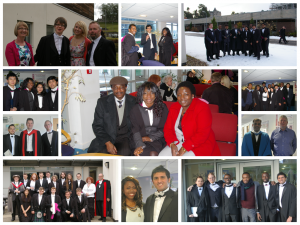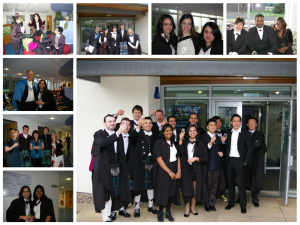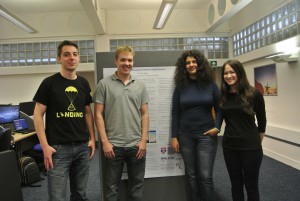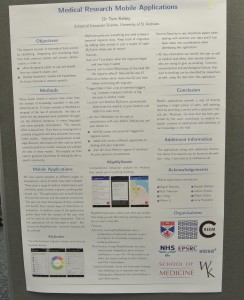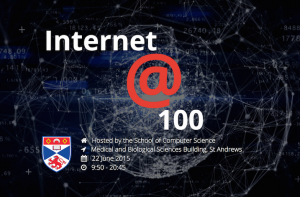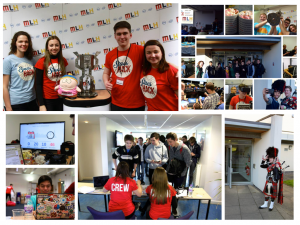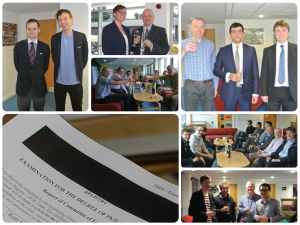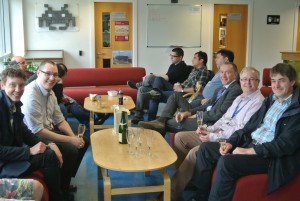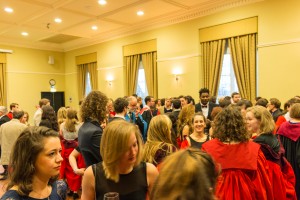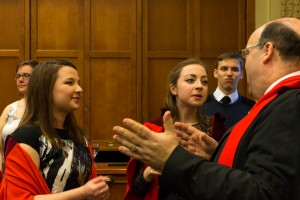The School will be celebrating more student successes and accomplishments next week, when our Senior Honours and PhD students graduate. We look forward to toasting their success at our Graduation reception next Wednesday. The occasion is a great opportunity for staff to meet family and friends and, for us to keep some photographic memories. Over the years graduation has involved cakes, fizz, laughter, changeable weather and lots of reminiscing as pictured below.
News
Computer Science Interns Accelerate Impact
Congratulations to Computer Science Interns Gergely Flamich, Jack Cargill, Iveta Dulova, Tatiana Tay and Finlay Marno for designing a prize winning poster, and providing an excellent demonstration session at the recent EPSRC Impact Showcase held in the School of Medicine.
The research presented, focuses on biomedical data science by identifying, integrating and simulating data from both previous studies and current collaborations.
The EPSRC awarded Impact acceleration award (IAA) funding to The University of St Andrews to promote a step change in the delivery of knowledge exchange. There were more than 30 projects funded by the EPSRC. The recent showcase offered an opportunity for university staff and students to find out more about the projects via posters, exhibits and demonstrations.
June 22nd: Internet at 100 Symposium with Dr Vint Cerf
On Monday June 22nd we are organising a one day symposium entitled “The Internet at 100”. This event features a host of distinguished speakers and culminates with a talk by Dr Cerf, one of the “fathers of the internet” and now vice-president and chief internet evangelist at Google.
The Internet is, of course, not 100 years old. It’s not even quite 50 years old but the talks at this event will look at its history, its current state and forward to what it might look like at 100. We are looking forward to a day of inspiring talks, time to network and socialise but also time to look back while we consider what might be for the Internet.
The full website for this event can be found here: http://www.cs.st-andrews.ac.uk/i@100/
Event details
- When: 22nd June 2015 09:45 - 20:45
- Where: N Haugh, St Andrews
- Format: Symposium
End of Semester Round up
We have reached the end of semester 2 and so many events, activities and accomplishments have taken place, it’s worth reflecting on all the hard work and enthusiasm demonstrated by our talented students.
As stated previously the School is rated highly for student satisfaction, which echoes the continued strong student staff community cultivated by all.
The events and locations pictured below help to highlight why studying Computer Science at St Andrews is such an amazing experience.
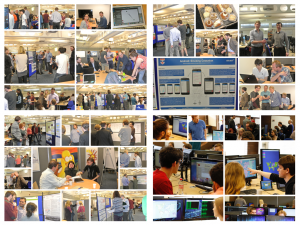
Clockwise from top left: Senior Honours demonstrate their final year projects. Junior Honours attempt world domination. PhD students present their posters.

Clockwise from top left: The May Dip, Torchlit procession, Christmas ceilidh and stunning St Andrews.
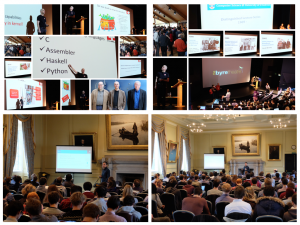
Computer Science Distinguished Lecture Series: Prof. Mothy Roscoe pictured at the Byre Theatre and Prof. Luca Cardelli pictured in Lower College Hall.
Images courtesy of Lisa Dow, Xu Zhu, Fearn Bishop, Saleem Bhatti and Simone Conte,
PhD Studentship: Reasoning about Racy Programs under Relaxed Consistency
A PhD studentship on “Reasoning about Racy Programs under Relaxed Consistency” is available in the School of Computer Science at the University of St Andrews, funded by Microsoft Research and EPSRC.
The project will involve developing reasoning principles and tools for relaxed memory consistency settings. This is a key problem in shared-memory concurrency at the low-level, whether in C or C++, or even higher-level languages such as Java.
The project will be supervised by Dr Susmit Sarkar at the University of St Andrews. Dr Jade Alglave of Microsoft Research Cambridge will be the Microsoft supervisor. During the course of their PhD, Scholars are invited to Microsoft Research in Cambridge for an annual Summer School, and there is also a possibility of paid internships during studies. The studentship is fully funded to pay fees and stipend for students with a relevant connection to the UK.
Applicants are expected to have or expect to obtain a UK first-class Honours or Masters degree (or its equivalent from non-UK institutions) in Computer Science, but the minimum standard we require is an upper second-class Honours degree or equivalent. Some experience in concurrent and/or functional programming and an aptitude for mathematical subjects are required. Knowledge and experience of one or more of formal verification, mechanised proofs, and programming languages is highly desirable.
For further information on how to apply, see our postgraduate web pages. Ideally the student will start in October 2015, or as soon as possible thereafter. Further details on the project and suggested reading is available from Dr Susmit Sarkar.
Codebase Open day
CodeBase Open Day
Friday 5 June 2015 – Friday 5 June 2015
13:00 – 16:00
Edinburgh
The CodeBase Open Day gives a chance for students, professionals and would-be developers and designers to learn more about amazing companies housed within the UK’s largest technology incubator.
It’s a chance to roam our corridors and drop in on companies for an informal chat and find out more about what they do .
Come and learn more about the 60 startups based within the building and explore what the startup scene has to offer. There will also be series of drop-in talks so those who attend get the opportunity to hear, first hand, what it’s like to work for some of the most exciting and interesting tech companies in Edinburgh.
Further details and ticket information: https://www.eventbrite.co.uk/e/codebase-open-day-tickets-16594864687
Event details
- When: 5th June 2015 13:00 - 16:00
PhD Viva Success
Congratulations to To Chris Schneider, who has successfully defended his PhD thesis. Chris is pictured celebrating with supervisor Prof Simon Dobson, external examiner Dr Radu Calinescu from the University of York, and internal examiner Dr Graham Kirby.
First IDIR Summer of V’s workshop
Computer Science was well represented at a workshop on the challenges of variability in data-driven research that was held earlier this week.
Event details
- When: 18th May 2015 13:00 - 17:00
- Format: Workshop
PhD Scholarship in Data Science
Potential PhD students with a strong background in Computer Science are encouraged to apply for this three-year studentship funded by the Research Council of the European Commission (ERC). The student will work within an interdisciplinary team of researchers from Computer Science and Geography in the WORKANDHOME project (ERC Starting Grant 2014), which investigates how home-based businesses are shaping society and space.
The student will examine the Computer Science challenges within this research project. The exact scope of the PhD project is open to discussion but we anticipate that the successful candidate will be working broadly on Data Science topics, potentially covering one or more of the following areas: cloud computing, social network analysis and agent-based modelling. This is a unique opportunity to work at the cutting edge of systems research. Come join us in St Andrews.
Funding Notes: The studentship will cover UK/EU tuition fees and an annual tax-free stipend of approximately £13,000. Funding will be for three years of full-time study, starting asap.
Applications: It is expected that applicants should have or expect to obtain a UK first-class honours degree (or its equivalent from non-UK institutions) in Computer Science but the minimal standard that we will consider is a UK upper-second class Honours degree or its equivalent.
For further information on how to apply, see our postgraduate web pages. All interested candidates should contact Dr Adam Barker in the first instance to discuss your eligibility for the scholarship and a proposal for research.
Scott Lang Dinner 2015
Peter Redford Scott Lang (1850-1926) was a Professor of Mathematics at St Andrews University from 1879 until his retirement in 1921. He had studied at Edinburgh University, and taught there before being appointed to St Andrews. Having seen the “ordinary student fare of the mid nineteenth century and menus of term time dinners” he instigated the institution of ‘Common Dinners’ in the 1880s.
The original purpose of the dinners was to enable students to have a “decent and varied diet,” but ended up meaning much more than that to some. In 1926, L.J.D. Gibson wrote this about the dinners:

Aleksejs Sazonovs (school president), Ruth Hoffman, Aaron Quigley (DoR), Keno Schwalb and Cameron Wright
In 2015, the School of Computer Science invited its class representatives and student president to dine with the head of school, Professor Steve Linton and Director of Research, Professor Aaron Quigley at the annual Scott Lang Dinner. This was to thank the students for their service to their fellow students, the school and to the University. Everyone had a wonderful evening and it was a great opportunity to learn more about each other outside the school. We hope this is the start of a new and long lasting tradition for our staff and students.
Thanks to Xu Zhu who also attended for the images (CC by-SA 3.0 license).


